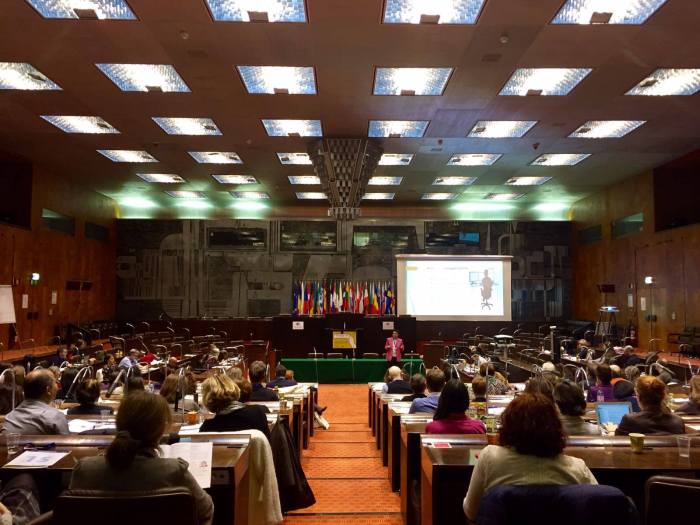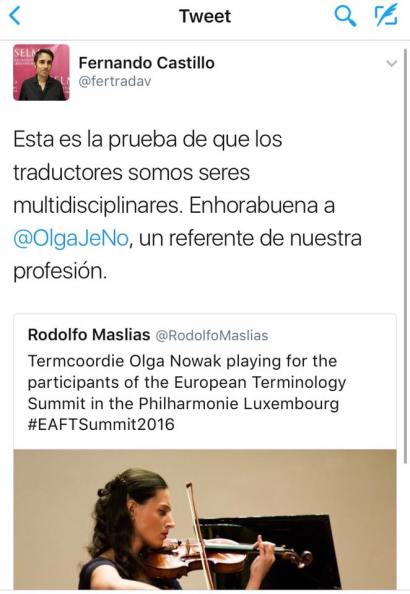
Traducción jurada en Guatemala inglés - español y otros idiomas desde 1992, exactitud, rapidez, confidencialidad, llevamos la traducción a su oficina o residencia; asimismo, capacitamos mediante diplomados 100% en línea en: 1) Formación para estudiantes de traducción jurada, b) Actualización profesional para el traductor jurado en servicio, c) Inglés legal internacional para abogados y personal jurídico; solicite información al WhatsAppB 502 5417-1388, julio@tradprof.com
29 diciembre 2016
26 diciembre 2016
20 diciembre 2016
16 diciembre 2016
14 diciembre 2016
09 diciembre 2016
08 diciembre 2016
06 diciembre 2016
05 diciembre 2016
02 diciembre 2016
Legal terminology: APPROPRIATE
-->
|
(adjective) suitable, proper
"This type of security is not appropriate for non-residents."
Synonym(s)
befitting, pertinent: "His vulgar language was not befitting a judge."
Antonym(s)
unsuitable: "Wearing shorts in a courtroom is unsuitable."
Other forms of the word
appropriate (verb): to take without permission or seize. "She appropriated all of the profits for herself."
appropriate (verb): to allocate or set aside for use. "The legislature appropriated funds to combat violence against women."
Notes
etymology: Late Latin: appropriare to take possession of, from ad to, for + proprius one's own
|
29 noviembre 2016
Court term: SERVE a process
TERMINOLOGÍA LEGAL PROCESAL /
PROCEDURE LEGAL TERMINOLOGY
Visit: CENTRO DE CAPACITACIÓN PROFESIONAL TRADPROF
28 noviembre 2016
The success of the EAFT Summit 2016!
The EAFT Summit 2016 has been a great success. It has been two days of different presentations, amazing speakers and great atmosphere. The European Association for Terminology (EAFT), in collaboration with TermCoord, has organised this Eighth European Terminology Summit presented on 14th and 15th of Novemberin one of the European Parliament buildings in Luxembourg. We have had the chance to listen various professors and terminology specialists from around the word such as: Mr. Valter Mavrič – Director-General for Translation (DG TRAD, EP), Mr. Henrik Nilsson – TNC / EAFT President, Mr. Rodolfo Maslias from TermCoord(DG TRAD, EP), Ms. Patricia Brenes – famous terminologist and blogger, Ms. Georgeta Ciobanu – an academic professor, Mr. Jordi Bover – Director of TERMCATor Mr. Alan Melby from the American Translators Association.
Do not worry if you have missed the EAFT Summit because you can still take a look at all the presentations, pictures and the most relevant tweets during the conference. 20.000 lenguas was present during the Summit basically on Twitter where we were very active by sharing relevant content of all the presentations. You can always take a look at the hashtag #EAFTSummit2016 to discover all our tweets and information which was shared during these two days.
Olga Jeczmyk from 20.000 lenguas (known on Twitter as @OlgaJeNo) was also playing a concert during the Summit.
The programme was international with three pieces:
- “Liebesleid” from the II Old Vienna Waltz in A Minor by Fritz Kreisler
- “Kuyawiak” from the II Mazurka in A Minor by Henryk Wieniawski
- “El Cant del Ocells” traditional Catalan song in E Minor original arrangement by Pau Casals
And we have received a very nice feedback on Twitter:
This is why we want to encourage you to take a look at all the available material and follow us for the next Summit information. We will be glad to share more news with you! Thank you for following us, it is a pleasure to share our content with all of you.
25 noviembre 2016
Terna examinadora Traducción Jurada inglés - español 2016.
--- El pasado miércoles 23 y jueves 24 de noviembre, 2016, tuve el privilegio de presidir una Terna Examinadora, nombrada por el Ministerio de Educación; para evaluar candidatos a Traductor Jurado; estas pruebas se desarrollaron en la Escuela Nacional Central de Ciencias Comerciales (10a. avenida 9-42 zona 1). Extiendo mi agradecimiento a los miembros de la terna: Ani Taracena del Busto, Técnica en Administración Educativa, Profesora de inglés y Traductora Jurada inglés - español quien estuvo a cargo de evaluar Gramática del inglés; Carolina Estrada, Profesora de Enseñanza Media en Idioma Español, Licenciada y Master en Lengua y Literatura del español, quien tuvo a su cargo evaluar Gramática del español. Además mi reconocimiento al personal de apoyo administrativo y contable del referido instituto así como a administrativos y funcionarios de la Dirección Departamental de Educación Norte. El suscrito estuvo a cargo de evaluar la aplicación de las buenas prácticas de la traducción jurada inglés - español en Guatemala. Orgullosamente ha sido la 16a. oportunidad de participar en ternas que he tenido (del año 2000 al presente) y por tercera vez, el MINEDUC autorizó el uso de Internet como herramienta para esta evaluación, la cual es indispensable para el traductor hoy en día. ---- Felicitaciones a las y los nuevos Traductores Jurados y me uno al compromiso de fortalecer el gremio con Traductores Jurados profesionales, competentes y actualizados en Guatemala.
Visite nuestra pagina en Facebook: CENTRO DE CAPACITACIÓN PROFESIONAL
18 noviembre 2016
LA TRADUCCIÓN: UNA PROFESIÓN POLIVALENTE.
LA TRADUCCIÓN: UNA PROFESIÓN POLIVALENTE
Sin duda, los traductores son capaces de asumir numerosas funciones. ¿Qué profesiones se ocultan detrás del término «traductor»? Entre otras, redactor, localizador, revisor, transcreador, terminólogo, profesor.
EL REDACTOR
Para lograr transmitir un mensaje de un idioma a otro, sin que el lector perciba que se trata de una traducción, se requiere de un excelente manejo del idioma de destino. Por ello, los traductores deben contar con la misma creatividad e imaginación que un escritor. Además, muchos de ellos tienen sus propios blogs, en los que escriben en su tiempo libre o que emplean para dar mayor visibilidad a su negocio. Para diversificar su actividad, algunos ofrecen servicios de redacción de contenido web.
EL LOCALIZADOR
La localización de idioma es un proceso de adaptación entre dos culturas que se aplica, sobre todo, al traducir software, videojuegos y sitios web. La misión del traductor consiste en adaptar con precisión las normas de una cultura a la otra. Esta es la fase de la globalización que tiene como objetivo transformar un producto de modo tal que dé la impresión de haber sido concebido en el lugar. El traductor realiza, entonces, un exhaustivo estudio socio-cultural con el fin de acercarse lo máximo posible a su público adaptando a este el producto terminado. Además, el localizador debe disponer de conocimientos informáticos necesarios para crear etiquetas de idioma, adaptar gráficos y formatos de páginas web, divisas, fechas, horas, etc.
EL REVISOR
Para que una traducción sea precisa y exacta, una segunda persona debe corregirla y revisarla sistemáticamente. La revisión se organiza en dos etapas. Por un lado, el revisor corrige las faltas de ortografía y los errores gramaticales que se le escaparon al traductor. Por otro lado, compara en forma paralela el texto fuente y el de destino con el fin de descubrir omisiones, cambios de significado, o peor aún, un contrasentido. El traductor también puede actuar como cliente, es decir, evaluar las producciones de sus colegas solo desde el punto de vista de la coherencia y la estilística.
EL TRANSCREADOR
¿Recuerda el artículo de Pauline Decker publicado en nuestro blog, en el que explica estupendamente el concepto de «transcreación»? En marketing, “[E]s un proceso creativo […] que consiste en transferir un bagaje cultural y emocional a la cultura de destino”. En este caso, el traductor no solo debe dominar las más mínimas sutilezas de la lengua para poder captar el alcance de los eslóganes, sino también conocer a la perfección las dos culturas y dar prueba de su imaginación para elaborar un nuevo gancho publicitario.
EL TERMINÓLOGO
Dado que la lengua está viva y en constante evolución, es esencial estar al tanto de los neologismos y de los nuevos conceptos con el fin de optar por una terminología coherente y uniforme. La terminología y la traducción son dos disciplinas estrechamente relacionadas: el terminólogo estudia las palabras en el contexto de una realidad cambiante, y el traductor las aplica. Esta práctica consiste en elaborar glosarios y fichas terminológicas, y analizar a fondo el campo léxico de un área sobre la base de una documentación pertinente y especializada. Algunos traductores colaboran con terminólogos experimentados, mientras otros combinan ambas funciones por falta de profesionales en el sector.
EL PROFESOR
Por último, en muchos casos, el traductor ofrece cursos de idiomas. Suele suceder entre jóvenes diplomados en busca de experiencia antes de lanzarse como independientes o para poder «llegar a fin de mes». No olvidemos que siguieron una sólida formación en idiomas y, seguramente, han vivido un tiempo en el extranjero para mejorar sus idiomas de trabajo.
De este modo, rompemos el famoso mito del traductor que vive enterrado entre libros.
Tomado de: http://culturesconnection.com/es/la-traduccion-una-profesion-polivalente/
13 noviembre 2016
10 noviembre 2016
Images as part of technical translation courses: implications and applications
"The visualisation and description of images from different perspectives trigger creativity in translation work, and help to develop pertinent documentation and translation strategies. As a result, translation courses should include activities involving the analysis and description of images, and the development of strategies that link the visual and the verbal component of the text with previous and newly acquired knowledge."
Images as part of technical translation courses: implications and applications1 Maribel Tercedor, Esperanza Alarcón-Navío, Juan A. Prieto-Velasco and Clara I. López-Rodríguez, Department of Translation and Interpreting, University of Granada, Spain
05 noviembre 2016
02 noviembre 2016
LIABILITIES
LIABILITIES:
‐‐ amounts owed by a company to others. Current liabilities are those amounts due within one year or less and usually include accounts payable, accruals, loans due to be paid within a year, taxes due within a year, and so on. Long‐term liabilities normally include the amounts of mortgages, bonds, and long‐term loans that are due more than a year in the future.
01 noviembre 2016
27 octubre 2016
25 octubre 2016
Legal context and framework to translate a will to and from Florida, USA.
How to translate a will from and for Florida:
South Florida Commercial and Probate Litigation Firm
South Florida Commercial and Probate Litigation Firm
Visite nuestra página institucional en Facebook:
23 octubre 2016
TALLERES DE TRADUCCIÓN JURADA INGLÉS - ESPAÑOL NOVIEMBRE - DICIEMBRE 2016
Le invitamos a conocer nuestra página institucional en Facebook:
Centro de Capacitación Profesional TRADPROF
Parents, father, mother, relatives.
PARENTS.
"Los padres" (el padre y la madre). No quiere decir "parientes". Parent, en singular, es, o bien el padre o la madre. "Parientes" se dice relatives.
"Los padres" (el padre y la madre). No quiere decir "parientes". Parent, en singular, es, o bien el padre o la madre. "Parientes" se dice relatives.
22 octubre 2016
20 octubre 2016
IDIOM, LANGUAGE
IDIOM, LANGUAGE. La primera significa "modismo", la segunda es "idioma".
Diccionario de dudas inglés-español, José Merino, 2a. edición corregida, Editorial Paraninfo,Madrid, España.
Diccionario de dudas inglés-español, José Merino, 2a. edición corregida, Editorial Paraninfo,Madrid, España.
12 octubre 2016
07 octubre 2016
Multinacionales de traducción: el coordinador o gestor de proyectos
Multinacionales de traducción: el coordinador o gestor de proyectos

Las empresas grandes (multinacionales, compañías de gran envergadura con millones de trabajadores, etc.) necesitan y solicitan servicios a escala mundial. Así, cualquier relación entre empresas multinacionales va acompañada de una serie de requisitos y exigencias que solamente ciertas empresas pueden cumplir. Ya sea como proveedores de materias primas, tecnologías industria o servicios, las multinacionales poseen la capacidad de satisfacer las necesidades de otras multinacionales. En este caso, las multinacionales de traducción no son una excepción.
Desde hace unos meses, tengo la oportunidad de pertenecer a una de estas multinacionales como coordinador de proyectos, y soy testigo de su sistema de trabajo. Por respeto profesional, no daré el nombre de la empresa para la que trabajo, ni nombres de clientes con los que trato. Me limitaré a dar una descripción general de cómo se trabaja en estos ambientes y a dar mi opinión al respecto e invito a que los lectores aporten su experiencia e ideas con comentarios una vez hayan leído este artículo.
Las empresas grandes necesitan y solicitan servicios a escala mundial. Las multinacionales de traducción no son una excepción.
Como sucede en las grandes empresas y multinacionales, el trabajo debe ser organizado y eficiente para asegurar una mejor producción y productividad. Ahora bien, dependiendo de la agencia, el rol del coordinador de proyecto puede tener mayor o menor implicación en la producción de las traducciones. A saber, cuanto mayor sea la agencia, “menor” será la implicación del coordinador o gestor de proyectos. Cuando hablo de implicación, me refiero a ciertas tareas que en agencias más pequeñas recaen en la figura del gestor de proyectos. Por ejemplo, todo lo referente a números (presupuestos, tarifas, facturación) se lleva a cabo por un departamento en concreto que es el que recibe los encargos y los evalúa, y entrega las versiones finales de las traducciones. En consecuencia, todo contacto (directo) con el cliente queda fuera de del alcance del coordinador de proyectos. Esto, que puede sonar escandaloso de buenas a primeras, tiene sus ventajas:
- Permite al coordinador/gestor de proyectos centrarse en el producto: el texto a traducir.
- Permite un análisis óptimo de las necesidades del texto dependiendo del formato en el que nos lo hayan entregado: .pdf, .doc, .xls, .ppt, .txt, etc.
- Escoger las herramientas de traducción que mejor le convengan y/o procesar el texto mediante otros departamentos si es necesario. Por ejemplo, extraer el texto de una imagen si nos han pedido traducirlo para el proyecto.
- Mayor tiempo para la búsqueda de los lingüistas que vayan a participar en el proyecto. Aunque, dependiendo del cliente, puede que ya se cuente con un equipo de profesionales previo (esto podemos comentarlo en otro artículo).
- El flujo de dudas entre proyecto-lingüistas-cliente pasa por más intermediarios, pero permite un mayor control de los mismos.
- A la hora de la entrega, el coordinador de proyectos se ha de centrar que el formato del documento final coincida con el de origen.
Estas son solo algunas de las de las tareas que los coordinadores/gestores de proyectos deben realizar. Como he dicho antes, cuanto mayor sea la agencia de traducción, “menores” serán las tareas que deba llevar a cabo. Es una verdad a medias, ya que también han de llevar a cabo tareas que dependan de otros departamentos a los que se está conectado, como por ejemplo: las hojas de seguimiento. Hojas de seguimiento para todo: para llevar un control de los proyectos durante un mes para un cliente en concreto, a cuántos idiomas se traduce, cálculo de palabras (nuevas y coincidentes), entre otras características. Afortunadamente, para estas hojas de seguimiento, los sistemas TAO (Traducción Asistida por Ordenador) ofrecen funciones que nos permiten filtrar y extraer trabajos por números de asignación, nombre de cliente, entre otras características. Este seguimiento es vital para llevar un control de todos los proyectos que se realicen para un cliente.

Esto es solo un pequeño boceto de lo que se puede llegar a hacer como gestor de proyectos en una multinacional de traducción. Si bien es cierto, cada empresa es distinta; y tanto organización de sus profesionales como el enfoque comercial también es distinto. Para cualquier profesional que quiera ampliar sus habilidades dentro del mundo de la traducción es altamente recomendable empezar en agencias de este tipo porque su flujo y cantidad de trabajo es enorme y se aprende a estar preparado para cualquier situación del mercado.
En futuros artículos intentaré explicar otros roles profesionales, tipos de clientes (aún por definir), alguna que otra anécdota. Esto es todo amigos, espero que este primer artículo os guste. Hasta la próxima, y que tengáis encargos de traducción con fechas de entrega razonables y tarifas justas.
Omid Saheb
27 septiembre 2016
¿Ley del Traductor Jurado o Autorizado en Guatemala?
 |
Este es el Decreto 251 de fecha 22 de noviembre de 1879, Ley del Traductor Autorizado vigente en Guatemala, el cual en sus artículos 1o. y 6o. cita al "traductor autorizado". --------- Si observamos, en ninguna parte del texto se lee, TRADUCTOR JURADO. Hasta la fecha, ignoro de dónde o cómo se formó tal frase. Una posibilidad es que en el proceso de convertirse en Traductor con fe pública y validez legal, se exige al candidato que aprueba su examen oficial, que "bajo juramento" realice todas las traducciones que se le encomienden; posiblemente de ahí surja tal confusión. ------ Además, en el artículo 37o. de la Ley del Organismo Judicial se consigna: "traductor autorizado" y no "Traductor Jurado"; otro argumento para afirmar que esta última denominación no es la técnicamente correcta en Guatemala. ------ Quizás por la influencia de España, donde sí existe el Traductor Jurado, acá en Guatemala, también se le denomine así.----- Definitivamente, este es un punto de investigación científica que una tesina o tesis de las ciencias lingüísticas podría desarrollar para confirmar o descartar lo anterior.
Le invitamos a conocer nuestra página en Facebook: CENTRO DE CAPACITACIÓN PROFESIONAL TRADPROF
|
20 septiembre 2016
When Your Miranda Rights Get Lost in Translation

Photo by Flickr user Elvert Barnes
This year marks the 50th anniversary of Miranda v. Arizona, the landmark US Supreme Court case that required law enforcement officials to read you your rights upon every arrest. Since that case, any statement made to law enforcement is inadmissible if the defendant was not first informed of his or her Fifth and Sixth Amendment rights—the right against self-incrimination and the right to consult with an attorney before answering any questions.
Even if you've never been arrested, you've seen enough movies and television police procedurals to know the familiar refrain: You have the right to remain silent, anything you say can and will be used against you, and so on.
But for primarily Spanish-speaking people in the United States—which has become the world's second-largest Spanish-speaking country after Mexico—those rights can easily get lost in translation. In countless cases across the US, Spanish-speaking defendants have been read incorrect or mistranslated versions of their rights, where butchering words like "free" and "right" can cost someone their best shot in court.
Now that could all change: The American Bar Association (ABA), at its annual conference earlier this month, voted unanimously to create a uniform Spanish-language Miranda warning and urged law enforcement agencies to adopt such a warning for defendants who do not speak English well or at all.
"As we looked into it, we discovered that too often Miranda is mistranslated, and that shouldn't happen," Alexander Acosta, who chairs the ABA's Special Committee on Hispanic Legal Rights and Responsibilities, told VICE. "This is something that should be very straightforward."
Every year, law enforcement across the country use Spanish-language Miranda warnings in 874,000 arrests, according to a report from the committee. In many of those instances, inaccurate translations that could potentially violate a person's civil rights can lead to excluded statements in court. But countless other incidents slip through the cracks, where a person did not understand their rights and their incriminating statements are used anyway.
"Even if there is a one-in-1,000 error rate, you can imagine how significant that would be nationally," Acosta said.
The problem is not uncommon: The committee's report lists dozens of instances of bad translations, including the use of Spanglish, and completely made-up Spanish words like "silento." (The Spanish word for silent is "silencio.") In other instances, words were found to be mistranslated, according to the ABA Hispanic committee's report: One Ohio case used the word for right-hand side, instead of a legal right. In a few different cases, defendants were told they had the right to "apuntar un abogado"—to "point at" a lawyer, rather than to appoint one.
In other situations, bad translations can lead to complete inaccuracy as to what rights the Fifth and Sixth Amendments even afford you. In Minnesota, a defendant was told of a right "not to say nothing." Others were told of a "right to answer questions."
One high-profile case in 2013 led to some clarification on the issue of Miranda translation. That case stemmed from a 2008 incident in which defendant Jeronimo Botello-Rosales and four others were arrested and charged with conspiracy to manufacture more than 1,000 marijuana plants. Botello was also charged with illegal possession of a firearm, according to court records.
Upon arrest, Botello-Rosales was read his rights, first in English, and then in Spanish. Officers said he waived those rights and proceeded to spout off a number of incriminating statements, including his alleged connection to a marijuana operation and about his immigration status, according to a brief.
Botello-Rosales's lawyer, Michael R. Levine, filed a motion to suppress his client's post-arrest statements, something not uncommon for such a case. Here, though, Levine had the court interpreter listen to the Spanish-language warning read by the arresting detective on the stand.
"He finished, and then I turned to the interpreter who was in the back, and I said, 'Well, how did it go?' And she said, 'Well, actually, he made a couple of mistakes,'" Levine told VICE. "And I immediately perked up and said, 'What do you mean mistakes?'"
It turned out that, in his warning, the detective garbled the translation and misinterpreted the word "free," as in "without payment." According to court documents, the detective informed Botello-Rosales, "If you don't have the money to pay for a lawyer, you have the right. One who is free could be given to you." But the version of "free" he used was the Spanish word "libre," which would be interpreted as "available," or "at liberty" to provide service. The Spanish word for "could" instead of "would" was also in dispute, as it is the government's obligation to provide a free attorney, not a choice.
The detective later admitted that he didn't always deliver the Miranda warnings the same way, but added that he always used the word "libre" in that way, according to court documents.
"He'd been doing it wrong for 25 years," Levine said. "He thought, honestly, that the word 'libre' in Spanish meant 'at no cost,' which it doesn't."
The district court nonetheless denied the motion to throw out his post-arrest statements, finding that Botello-Rosales probably understood the English Miranda warning. He pleaded guilty, on the condition that he could appeal the judge's order denying the motion to suppress.
On appeal, the Ninth Circuit panel reversed the lower court's decision. The panel's opinion effectively said that Miranda rights must be translated correctly in order for them to be valid—reciting them properly in English is not enough. The case was remanded, and Botello-Rosales took a plea deal for a lesser sentence, according to Levine.
"This is something that's given probably thousands and thousands of times every year, to a myriad of defendants, and there's no reason to assume that they're not getting it wrong," Levine told VICE.
That case and others illustrate the need for a standard of some kind. Once the ABA commission puts together an official translation with help from law enforcement experts, it will look to promulgate the translation out through state attorneys general and local bar associations, according to Acosta.
"I think at the end of the day, if the American Bar Association says, 'This is one that we have vetted and we support,' I think many law enforcement agencies would certainly use that," Acosta told VICE. "Because it provides them a safeguard."
Of course, even a consistent Spanish-language warning is not a cure-all solution. For example, while the warning may be uniform, the Spanish language itself is not. The committee is working on trying to address regional or dialectal differences in its implementation to help mitigate this. And of course, there's human error: In some cases cited by the commission, even printed-out Spanish-language Miranda cards contained errors.
But the ABA's vote this month was a promising first step that could lead to translations not just in Spanish, but ideally in other languages—and a decision that defendants, attorneys, and judges could benefit from. During remarks to the commission ahead of the vote, Sixth Circuit Court of Appeals Judge Bernice Donald talked about her stint as a federal judge and said she hopes that her time on the bench was not marred by mistranslations.
"We have an opportunity with the passage of this resolution to make certain that Miranda is more than words," Donald said, echoing the theme of this year's ABA conference. "I spent 15-and-a-half years as a judge on the United States District Court, where I heard cases, and we had one Spanish-language interpreter. I hope that we were not one of the courts that engaged in any of those mistranslations. But this is serious."
Follow Paul DeBenedetto on Twitter.
03 septiembre 2016
02 septiembre 2016
01 septiembre 2016
Suscribirse a:
Comentarios (Atom)

































